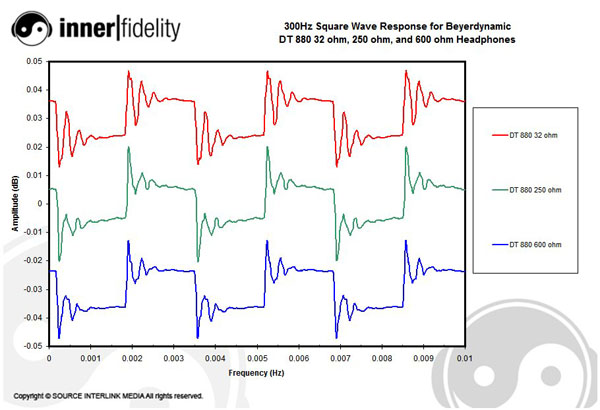| Columns Retired Columns & Blogs |
I wonder if there were any changes/silent revisions made to these cans since this article was published.
It is the ratio of the output impedance of the amp to the load impedance of the headphones that results in the “damping factor” of the system. Damping factor is the load impedance divided by the source impedance. As a rule of thumb, a damping factor of 10 or more is desirable for the source to be able to drive the load with authority. For example, if the amp has an output impedance of 10 ohms, you want the headphones to be at least 100 ohms or more in order for the amp to make the headphone driver move accurately with the audio signal.
So, what has all this got to do with Beyerdynamic DT 880 headphones? Simply this: For any given headphone amplifier or source, you want to use the highest impedance DT 880 that will still allow you to reach your desired listening level on the source you are using. Higher impedance headphones will give you a higher damping factor for a given amplifier. Using a lower impedance headphone than necessary means that your damping factor will be lower, and the resulting sound will be less “tight.”

The above graphs show the square wave and impulse responses of the three DT880 impedance headphones. Here you can see that the 32 ohm DT 880 rings markedly more than the other two headphones. The output impedance of the amplifier I use to test headphones is less than 2 ohms, so the damping factor is about 15 for the 32 ohm Beyers. The 250 ohm DT 880 would have a damping factor of a bit over 100, and the better damping is evident in the reduced ringing of the 250 ohm headphones over the 32 ohm cans. Similarly, the 600 ohm headphone would have a damping factor of about 300, and shows very slightly less ringing. Again, ten to one is adequate; the diminishing return of the larger damping factor of the 600 ohm over the 250 ohm version is evident.
Listenng Tests
I performed two series of listening tests: one from a HeadRoom Balanced Max headphone amp, and one from an iTouch. In the listening tests on the Max (less than 2 ohm output impedance), I heard the 32 ohm version as somewhat more tizzy sounding in the highs than the the 250 ohm; and the 600 ohm version as only sightly more controlled over the 250 ohm version. All were fairly similar sounding other than that.
On the iTouch (output impedance 32 ohm) however, the differences between the 32 ohm and 250 ohm version were pretty stark. In this case, the damping factor of the 32 ohm headphone and the 32 ohm output impedance of the iTouch is 1 --- not good because the headphones and output of the iTouch will strongly interact. To my ears, the 32 ohm DT 880 version was significantly more confused sounding. When I switched to the 250 ohm I was surprised how much clearer it sounded than the 32 ohm DT 880. The 32 ohm did reach markedly higher volumes than the 250 ohm version; I generally had the volume set on ¾ for a solid listening level on the 32 ohm version, and the 250 ohm needed the volume almost at max for the same level, but it was certainly loud enough for me. The 600 ohm headphone sounded fine, but really didn’t get loud enough on the iTouch.
Summary
Beyerdynamic DT 880 32 ohm
While I found this headphone to be driven to satisfactory levels from portable devices, I felt the sound quality was degraded (likely by the poor damping factor) to the point that the price/performance ratio was poor. Essentially, you are not going to get DT 880-like performance from this pairing. I suggest that if you are looking for a portable headphone, the DT 880 32 ohm is a poor choice from a sound quality perspective. Additionally, you should be looking for a sealed design for portable use so that you will get some isolation from outside noise. I do not recommend this headphone.
Alternatives at or below this price would include: Denon AH-D2000 ($349; fast sounding); Shure SRH840 ($250; warm sounding); Audio Technica ATH-M50 ($199; slightly edgy but good otherwise); and the Skullcandy Roc Nation Aviator ($149; great sound, poor isolation).
Beyerdynamic DT 880 250 ohm
 The DT 880 is a long-standing staple for headphone enthusiasts who like clear and airy highs with a bit of “zing” in them. I felt the bass was strong but a bit loose, and felt the mid-range a little lacking relative to the warm lows and zippy highs. Never the less, this is clearly a good performer in its price/category. It’s lower impedance and decent efficiency makes them able to be used with a portable device satisfactorily as long as you are not looking for high-volume levels. I think this is a good general-purpose headphone when you don’t need isolation. Yup, recommended.
The DT 880 is a long-standing staple for headphone enthusiasts who like clear and airy highs with a bit of “zing” in them. I felt the bass was strong but a bit loose, and felt the mid-range a little lacking relative to the warm lows and zippy highs. Never the less, this is clearly a good performer in its price/category. It’s lower impedance and decent efficiency makes them able to be used with a portable device satisfactorily as long as you are not looking for high-volume levels. I think this is a good general-purpose headphone when you don’t need isolation. Yup, recommended.
Beyerdynamic DT 880 600 ohm
 If you are only going to be using these headphones with home or desktop gear, the DT 880 600 ohm is a good choice. With sonic characteristics largely like those of the 250 ohm version above, but with slightly more finesse in the highs, these headphones compare well with the best of the headphones in this class. Also recommended.
If you are only going to be using these headphones with home or desktop gear, the DT 880 600 ohm is a good choice. With sonic characteristics largely like those of the 250 ohm version above, but with slightly more finesse in the highs, these headphones compare well with the best of the headphones in this class. Also recommended.
Alternatives would include: the Sennheiser HD 600 (commonly $399; slightly veiled sounding); the AKG Q701 (commonly $399; slightly hard sounding); and the Denon AH-D2000 (MSRP $349; sealed; somewhat bright, but very accurate sounding).
Measurement Datasheets:
Beyerdynamic DT 880 32 ohm
Beyerdynamic DT 880 250 ohm
Beyerdynamic DT 880 600 ohm

I wonder if there were any changes/silent revisions made to these cans since this article was published.